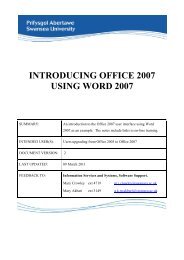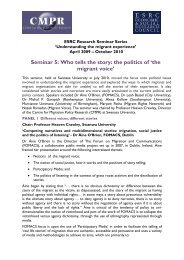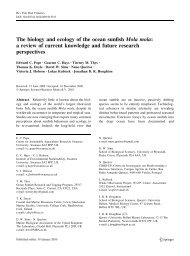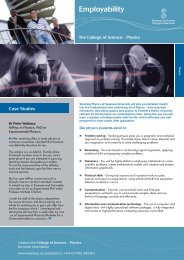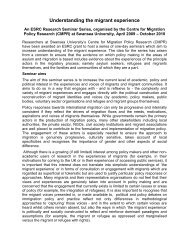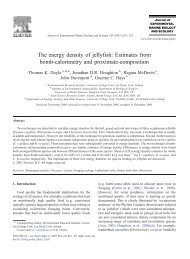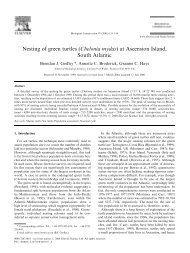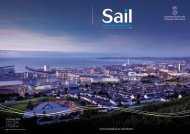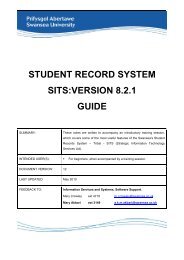Marine Ecology Progress Series 353:289
Marine Ecology Progress Series 353:289
Marine Ecology Progress Series 353:289
You also want an ePaper? Increase the reach of your titles
YUMPU automatically turns print PDFs into web optimized ePapers that Google loves.
Vol. <strong>353</strong>: <strong>289</strong>–301, 2008<br />
doi: 10.3354/meps07118<br />
MARINE ECOLOGY PROGRESS SERIES<br />
Mar Ecol Prog Ser<br />
Published January 17<br />
Influence of ocean currents on long-distance<br />
movement of leatherback sea turtles in the<br />
Southwest Indian Ocean<br />
Paolo Lambardi 1 , Johann R. E. Lutjeharms 2 , Resi Mencacci 1 , Graeme C. Hays 3 ,<br />
Paolo Luschi 1, *<br />
1 Dipartimento di Biologia, Università di Pisa, Via A. Volta 6, 56126 Pisa, Italy<br />
2 Department of Oceanography, University of Cape Town, Rondebosch 7700, South Africa<br />
3 Department of Biological Sciences, Institute of Environmental Sustainability, University of Wales Swansea, Singleton Park,<br />
Swansea SA2 8PP, UK<br />
ABSTRACT: Leatherback turtles Dermochelys coriacea spend most of their life in oceanic environments,<br />
whose physical and biological characteristics are primarily forged by sea current circulation.<br />
Water mass movements can mechanically act on swimming turtles, thus determining their routes, and<br />
can differentially distribute their planktonic prey. By integrating satellite tracking data with contemporaneous<br />
remote-sensing information, we analysed the post-nesting journeys of 9 leatherbacks with<br />
respect to oceanographic surface conditions. Tracked turtles showed large variations in migration<br />
routes and in final destinations, apparently without heading for specific foraging areas. Their complex<br />
tracks spread over wide regions around South Africa. Leatherbacks were greatly influenced by<br />
the currents encountered during their movements, with their trajectories displaying curves or revolutions<br />
in the presence of (and in accordance with) rotating water masses. An impressive similarity was<br />
observed between large parts of the turtle routes and those of surface drifters tracked in the same<br />
regions. Finally, leatherbacks remained associated for long periods with specific oceanographic<br />
features, which most probably offered them profitable foraging opportunities. These results agree<br />
with previous findings in showing a strong influence of oceanic currents and mesoscale features on<br />
the movements of South African leatherbacks, and additionally identify the role of current-related<br />
features in causing the observed route variability and in determining high-quality foraging hotspots<br />
for leatherbacks moving in the ocean.<br />
KEY WORDS: Satellite telemetry · Dermochelys · Remote sensing · Oceanography · Current drift<br />
Resale or republication not permitted without written consent of the publisher<br />
INTRODUCTION<br />
For animals travelling in a moving medium, the<br />
movement of the medium may have profound impacts<br />
on the animal’s trajectory. Classic examples concern<br />
the impact of wind on the journeys of birds and of<br />
ocean currents on the movement of marine animals,<br />
especially as regards larval dispersion (Dingle 1996,<br />
Alerstam et al. 2003). However, currents may also<br />
affect nektonic animals capable of strong active swimming,<br />
like sea turtles (Luschi et al. 2003a). Turtle<br />
hatchlings are advected around entire ocean basins by<br />
currents (Musick & Limpus 1997), but adult turtles<br />
could also be affected by current circulation in their<br />
movements (e.g. Girard et al. 2006). This applies even<br />
to the largest species of turtle, the pelagic-dwelling<br />
leatherback turtle Dermochelys coriacea, whose preferences<br />
for patchily distributed pelagic prey cause it<br />
to wander over large regions while feeding on<br />
macroplankton. Indeed, satellite tracking studies have<br />
shown that leatherbacks carry out extensive oceanic<br />
movements, following complex routes showing a high<br />
degree of inter- and intra-individual variation (Morreale<br />
et al. 1996, Eckert & Sarti 1997, Luschi et al.<br />
*Corresponding author. Email: pluschi@biologia.unipi.it<br />
© Inter-Research 2008 · www.int-res.com
290<br />
Mar Ecol Prog Ser <strong>353</strong>: <strong>289</strong>–301, 2008<br />
2003b, Ferraroli et al. 2004, Hays et al. 2004a,b, 2006,<br />
James et al. 2005, Eckert 2006).<br />
The oceanic areas visited by foraging turtles are<br />
mainly characterised by sea currents and related features,<br />
which can influence leatherback feeding-related<br />
movements in 2 main ways: (1) currents exert mechanical<br />
actions on swimming animals, thus affecting the<br />
shape of the route taken; (2) oceanic circulation is<br />
responsible for differential distributions of food<br />
resources in the ocean, determining the distribution of<br />
planktonic primary producers, and thus also of animals<br />
at higher trophic levels, including top predators like<br />
leatherbacks. In particular, eddies may concentrate<br />
nutrients and organisms, and thus represent patches of<br />
high prey abundance targeted by foraging turtles. By<br />
integrating satellite tracking findings with contemporaneous<br />
oceanographic data, the influence of these<br />
processes on ocean-moving leatherbacks can be reliably<br />
investigated. For instance, analysing the relationship<br />
between the turtle movement direction and the<br />
water flow in that area can highlight the marked influence<br />
of currents on turtle movements (e.g. Gaspar et<br />
al. 2006). Similarly, if specific oceanographic elements<br />
provide important feeding opportunities for turtles,<br />
prolonged sojourns in those areas would be expected.<br />
For the present study, we compiled tracking data<br />
from 9 leatherback turtles tracked over 8 yr during<br />
their wide-range oceanic movements in the SW Indian<br />
Ocean, and we integrated these with available oceanographic<br />
information. Three of these routes have been<br />
discussed in a previous paper (Luschi et al. 2003b), in<br />
which only sea current effects on the general route<br />
shapes were considered. Their inclusion in the present<br />
study allowed us to analyse movements performed<br />
over several years and varying in course and destinations,<br />
and thus to also investigate whether, and to<br />
which extent, intra- and inter-individual variations in<br />
migration patterns are linked to the spatio-temporal<br />
variability in oceanographic conditions of the region.<br />
MATERIALS AND METHODS<br />
Turtles and transmitters. Nine female leatherbacks<br />
nesting in the Maputaland <strong>Marine</strong> Reserve, on the<br />
eastern coast of South Africa, were followed through<br />
the Argos system during their post-nesting movements<br />
between 1996 and 2003. Three different models of<br />
transmitters, produced by Telonics and by the Sea<br />
Mammal Research Unit (University of St. Andrews,<br />
UK), were used. They were programmed with different<br />
duty cycles (Table 1) and placed on the carapace with<br />
harnesses (Luschi et al. 2003b). The Argos system provided<br />
location data classified into 6 accuracy levels,<br />
and the routes were reconstructed using all fixes and<br />
filtering out locations on land or producing ground<br />
speed values >10 km h –1 (a threshold estimated from<br />
high-accuracy locations only).<br />
Study area: physical setting. The SW Indian Ocean<br />
is an optimal region in which to investigate the behaviour<br />
of marine animals in relation to ocean currents.<br />
While the water flow of this region is dominated by the<br />
greater Agulhas Current system (Fig. 1a), a wide range<br />
of current types, water speeds, scales of motion and<br />
potential food sources are found here (Lutjeharms<br />
2006).<br />
The most prominent current in the SW Indian<br />
Ocean is the Agulhas Current, which flows along the<br />
east coast of South Africa following the continental<br />
shelf edge quite closely with a very stable trajectory.<br />
The current starts somewhere between the cities of<br />
Durban and Maputo, but the location of its northern-<br />
Table 1. Summary information for the 9 turtles tracked between 1996 and 2003. NA: estimation not available since ‘Elena’<br />
remained in coastal waters where no reliable sea surface height anomaly (SSHA) information was accessible<br />
Turtle Tracking period Transmitter Duty cycle Percentage of<br />
model<br />
route determined<br />
by currents<br />
Lara 16 Jan–18 May 1996 ST–14 Continuously on 84<br />
Nemi 31 Jan–30 Sept 1999 ST–6 Continuously on 78<br />
Sandra 31 Jan–11 Sept 1999 ST–6 Continuously on 69<br />
Resi 30 Jan–16 Jun 2000 ST–6 5 d off/1 d on 84<br />
Elena 2 Feb–3 Mar 2000 ST–6 Continuously on NA<br />
4 Mar–2 Apr 2000 5 d off/1 d on<br />
Ronel 13 Feb–15 Mar 2001 ST–6 Continuously on 40<br />
16 Mar–20 May 2001 5 d off/1 d on<br />
Alice 13 Feb–16 Mar 2001 ST–6 Continuously on 72<br />
17 Mar–8 Jun 2001 5 d off/1 d on<br />
Imola 13 Jan–30 Jan 2002 SRDL Continuously on 93<br />
Sara 29 Jan–16 Jul 2003 SRDL Continuously on 65
Lambardi et al.: Influence of ocean current on sea turtle movement<br />
291<br />
Fig. 1. (a) Schematic map of the general circulation of surface currents in the<br />
SE Atlantic and SW Indian oceans. Redrawn from Richardson et al. 2003.<br />
(b) Routes of 21 surface drifters tracked as they passed within the region<br />
delimited by the black box. Different colours highlight distinct movement patterns.<br />
Pink: drifters remaining at low latitudes; green: drifters circuiting in<br />
areas off the Agulhas mainstream; black: drifters tracked only within the<br />
Agulhas mainstream; blue: drifters entering the Atlantic Ocean; red: drifters<br />
being captured by the Agulhas Return Current (thick track: drifter shown in<br />
Fig. 4). The duration of plotted trajectories ranges from 51 to 657 d (mean ± SE,<br />
181.9 ± 35.1 d).White and green dots: positions of turtle nesting sites<br />
most expression is uncertain and quite variable (Flemming<br />
& Hay 1988). The current is 60 to 100 km wide<br />
at the sea surface (Beal & Bryden 1999), and speeds in<br />
its core can exceed 7.2 km h –1 , decreasing with distance<br />
offshore. Its waters are distinctly warmer and<br />
saltier than the ambient water masses, and are generally<br />
oligotrophic with strips of higher productivity at<br />
its borders (Lutjeharms 2006).<br />
Southwest of the continent, the current<br />
retroflects with most of its water returning<br />
eastward to the Indian Ocean along<br />
the Subtropical Convergence as the<br />
Agulhas Return Current (Fig. 1a) (Lutjeharms<br />
& Ansorge 2001). At the western<br />
termination of the Agulhas Current,<br />
huge rings of water are shed by the<br />
occlusion of the retroflection loop, subsequently<br />
drifting into the South Atlantic<br />
Ocean at 5 to 15 km d –1 . The Agulhas<br />
Return Current exhibits large meanders,<br />
and its surface speed decreases with distance<br />
eastward. Events of high productivity<br />
are spasmodically found at the<br />
Subtropical Convergence (Llido et al.<br />
2005). At 60 to 70° E, the effect of the<br />
Agulhas Return Current is lost and the<br />
flow along the Subtropical Convergence<br />
is much weaker.<br />
The Benguela Current (Fig. 1a) on the<br />
western side of southern Africa has<br />
entirely different characteristics. It represents<br />
the weak eastern boundary current<br />
of the SE Atlantic Ocean: estimates<br />
of the mean surface drift give average<br />
drift rates of 5 to 15 km d –1 (Wedepohl et<br />
al. 2000). Adjacent to the Benguela Current<br />
proper lies a wind-driven coastal<br />
upwelling system (Shannon & Nelson<br />
1996), a highly productive region<br />
extending up to the shelf edge, with<br />
occasional filaments of cold, nutrientrich<br />
water spreading far offshore (Lutjeharms<br />
et al. 1991).<br />
Finally, the region offshore SE Africa is<br />
characterised by the passage of large<br />
eddies formed in the narrows of the<br />
Mozambique Channel and drifting poleward<br />
(de Ruijter et al. 2002). These deepsea<br />
eddies form an important component<br />
of the circulation in the area and may be<br />
joined by similarly intense eddies coming<br />
from east of Madagascar (e.g. de<br />
Ruijter et al. 2003).<br />
This assemblage of an intense western<br />
boundary current, a weak eastern<br />
boundary current adjacent to a coastal upwelling, and<br />
a host of eddies of different dimensions, intensities and<br />
senses of rotation represents nearly the full range of<br />
ocean features that marine animals could encounter<br />
anywhere in the world.<br />
Remote sensing and oceanographic data. The<br />
reconstructed turtle routes were analysed in relation to<br />
contemporaneous satellite remote-sensing data on sea
292<br />
Mar Ecol Prog Ser <strong>353</strong>: <strong>289</strong>–301, 2008<br />
surface temperature (SST), sea surface height anomalies<br />
(SSHA) and chlorophyll (chl) a concentration.<br />
SST was derived from multi-channel data sensed<br />
through the Advanced Very High Resolution Radiometer<br />
(AVHRR) on board the NOAA 14 satellite (nominally<br />
1 km spatial resolution). Data were gridded by<br />
optimum interpolation by the Modular Ocean Data<br />
Assimilation System and made available by the Naval<br />
Research Laboratory (Stennis Space Center, Mississippi,<br />
USA; http://www7320.nrlssc.navy.mil/altimetry).<br />
SSHA images, derived from measurements made by<br />
Jason, TOPEX/Poseidon, Geosat Follow-on, ERS-2 and<br />
Envisat altimetry satellites, are available from the Colorado<br />
Center for Astrodynamic Research (University<br />
of Colorado, Boulder, Colorado, USA; http://argo.<br />
colorado.edu/~realtime/gsfc_global-real-time_ssh/) in<br />
the form of 10 d averages ending at the given date.<br />
They reveal variations in course and speed of major<br />
currents and identify the occurrence of mesoscale<br />
oceanographic features, like eddies or filaments, while<br />
SST images give indications of the general course of<br />
the Agulhas Current. The integration of these 2 information<br />
sources is particularly valuable for portraying<br />
rapidly changing oceanographic features, such as<br />
passing eddies.<br />
Finally, ocean colour images were obtained from the<br />
Sea-viewing Wide Field-of-view Sensor (SeaWiFS)<br />
on board the Orb-View 2 satellite (SeaWiFS Project,<br />
http://oceancolor.gsfc.nasa.gov/). They were used to<br />
get indications of the chl a concentration in the upper<br />
layers of the water column and thus, their productivity.<br />
Additionally, we considered the existing<br />
observations of surface Lagrangian buoys<br />
tracked with Argos in the same region as<br />
turtles. Drifter data were obtained from<br />
the Atlantic Oceanographic Meteorological<br />
Laboratory (www.aoml.noaa.gov/<br />
phod/trinanes/xbt.html). These drifters are<br />
equipped with a drogue that acts like an<br />
underwater sail, helping them to move<br />
within the current flow and minimising<br />
wind drag (Stewart 2003). In this way, they<br />
provide reliable information on the circulation<br />
of the upper layers of the water column<br />
(up to 100 m), where leatherbacks<br />
spend most of their time (Sale et al. 2006).<br />
To compare these routes to those of the<br />
turtles, we chose all drifters (n = 21) that<br />
passed through the region from 25 to<br />
30° S, 32 to 36° E in 1996 to 2003 (see<br />
Fig. 1b). We considered the tracks of these<br />
drifters starting when they entered this<br />
region and onwards. To evaluate their<br />
speed while in the Agulhas mainstream,<br />
the track segments running along the<br />
eastern coast of South Africa were selected (n = 14).<br />
The possibility of placing drifters concurrently with the<br />
departure of turtles from nesting beaches would have<br />
been ideal. However, in a current as geographically<br />
stable as the Agulhas Current (Gründlingh 1983), nonsimultaneous<br />
drifters are reliable estimators for<br />
Lagrangian motion. This is not completely true outside<br />
of the current itself, where a wide range of circulation<br />
characteristics are found.<br />
GIS software (ArcView GIS 3.2) was used to plot the<br />
routes of turtles and drifters and to superimpose the<br />
turtle routes on the remote sensing images. To calculate<br />
the percentage of each turtle route determined by<br />
ocean currents (Table 1), we summed the length of the<br />
various segments of each turtle route that were conservatively<br />
estimated to derive from the direct influence<br />
of current-related features (see next paragraph),<br />
divided by the total length of the route.<br />
RESULTS<br />
General movement patterns<br />
The tracks of the 9 leatherback turtles showed a<br />
large degree of variation (Fig. 2), with a number of different<br />
movement patterns. A first distinction can be<br />
made between the 4 turtles that remained at low latitudes<br />
at least for several weeks and the 5 animals moving<br />
SW soon after leaving the nesting areas. Of these,<br />
2 kept a course closely parallel to the South African<br />
Fig. 2. Reconstructed routes of 9 leatherback turtles moving around<br />
the southernmost part of the African continent. See text and Fig. 1 for<br />
further details
Lambardi et al.: Influence of ocean current on sea turtle movement<br />
293<br />
coastline, while 3 headed more offshore,<br />
in 2 cases spending long periods in<br />
seemingly restricted areas. Of the 4 former<br />
turtles, 1 (‘Elena’) remained in<br />
inshore waters for the whole tracking<br />
period (2 mo), while the other 3 moved<br />
offshore, where ‘Resi’ and ‘Alice’ performed<br />
large loops. Further, other patterns<br />
may also be discerned for the 2 turtles<br />
entering the SE Atlantic Ocean and<br />
for the 1 turning eastward.<br />
Drifters passing off NE South Africa<br />
displayed movements broadly similar to<br />
those of the turtles (Fig. 1b). Three of the<br />
21 selected buoys remained at latitudes<br />
294<br />
Mar Ecol Prog Ser <strong>353</strong>: <strong>289</strong>–301, 2008<br />
The similarity between the movement of drifters and<br />
turtles may extend into the Agulhas Retroflection and<br />
Return Current region. For instance, the tracks of<br />
‘Lara’ and 1 drifter shown in Fig. 4 were both recorded<br />
in 1996, but about 4 mo apart, and provide important<br />
indications of how closely turtles are tied to the water<br />
movement in the region south of the continent. A major<br />
consistency was the tendency of the turtle and the<br />
drifter to follow the water through the turbulent Agulhas<br />
Retroflection and to emerge in the Agulhas Return<br />
Current. When approaching the Retroflection region,<br />
both the turtle and the drifter underwent extensive<br />
anti-clockwise motion at about 22° E: ‘Lara’ once, and<br />
the drifter twice. This can therefore be assumed to<br />
have been the general location of the Agulhas<br />
Retroflection at the time. Both then escaped from the<br />
Retroflection carrying out gyrations in Agulhas rings to<br />
the west of the Retroflection. Subsequently, they were<br />
both carried away in the Agulhas Return Current,<br />
albeit during rather different periods (April vs. October<br />
1996).<br />
On the whole, when tracked turtles found themselves<br />
within the Agulhas Current mainstream, their<br />
movement fit closely with the SW current flow. On the<br />
other hand, the Agulhas mainstream possibly offered<br />
few feeding opportunities to leatherbacks, as no clear<br />
signal of enhanced productivity in this region was<br />
identifiable from ocean colour images. During their<br />
stay in this area, the turtles indeed frequented waters<br />
where the chl a density was always below 0.2 mg m –3 .<br />
The inter-oceanic shift<br />
Two turtles (‘Sandra’ and ‘Sara’) made an inter-oceanic<br />
shift to the Atlantic Ocean (Fig. 2). In this case, surface<br />
currents also played a major role in determining this<br />
movement, highlighted as well by the frequent occurrence<br />
of such shifts in surface drifters (Fig. 1b). Both turtles,<br />
which were tracked in different years, were clearly<br />
in the core of the Agulhas Current during the last part of<br />
their journey in the Indian Ocean (see Fig. 5a for ‘Sara’),<br />
moving at rates of 62.3 and 119.6 km d –1 , respectively,<br />
between the longitudes of Port Elizabeth and Cape<br />
Town. As evident in the SST images, they then moved<br />
out of the main current from the western edge of the Agulhas<br />
Retroflection, without being retained in the<br />
Retroflection loop. During this shift, their movements<br />
were in accordance with the main surface circulation in<br />
the area. SSHA images show that the region directly<br />
west of the Retroflection was indeed filled with a collection<br />
of eddies (Fig. 5b for ‘Sara’), which were moving NW<br />
at the time. The influence of such features on turtle<br />
movements is shown comprehensively by the track of<br />
‘Sara’ (Fig. 5b), which followed the contours of SSHA<br />
fairly well. On escaping from the Agulhas Retroflection,<br />
she was caught by an anti-cyclonic eddy that made<br />
her track loop anti-clockwise (around 13 March). A second<br />
anti-cyclonic eddy subsequently led her to culminate<br />
in the farthest eastward divergence from a straight<br />
meridional track (16 March), before leading her to the<br />
westernmost excursion on 21 March.<br />
Entering the Atlantic Ocean allowed<br />
‘Sandra’ and ‘Sara’ to access the upwelling<br />
regions along the west coast of southern<br />
Africa, where large concentrations of<br />
gelatinous macroplankton occur (Brierley<br />
et al. 2001). They indeed moved equatorward<br />
(Fig. 2), marginally following the<br />
weak flow of the Benguela Current and<br />
keeping outside the main corridor of intense<br />
northwest-oriented Agulhas rings<br />
(Schouten et al. 2000). They stayed outside<br />
the intense part of the coastal upwelling<br />
and only at a latitude of 26° S did they<br />
move toward it. There is no clear indication<br />
from any environmental data that this<br />
coastal approach was induced by any<br />
ocean currents.<br />
Mesoscale eddies<br />
Fig. 4. Tracks of the turtle ‘Lara’ (thick line) and of a surface drifter<br />
(no. 9421931; thin line) moving in the Indian Ocean in 1996. NS: nesting site<br />
Eddies represent a relevant oceanographic<br />
feature in the study region, and<br />
indeed many of them were identified<br />
during the turtle tracking period. In most
Lambardi et al.: Influence of ocean current on sea turtle movement<br />
295<br />
Fig. 5. (a) Route of the turtle ‘Sara’ as she entered the southern Atlantic Ocean<br />
superimposed on a sea surface temperature (SST) image recorded on 15 July<br />
2003. (b) Details of her inter-oceanic shift (dates shown) superimposed on a sea<br />
surface height anomaly (SSHA) image recorded on 18 March 2003. Direction of<br />
eddy rotation in the area revealed by SSHA indicated by dashed arrows: anticlockwise<br />
water movements are associated with anti-cyclonic eddies (positive<br />
anomalies; red) and clockwise water movements with cyclonic eddies (negative<br />
anomalies; blue). Black arrows indicate the turtle’s direction of movement<br />
cases, the identified eddies were not ephemeral and<br />
were moving either poleward (in the Indian Ocean), or<br />
equatorward (in the Atlantic). The 8 turtles tracked in<br />
oceanic waters encountered 42 eddies, for a total of<br />
33 087 km (49.8% of total route lengths) covered<br />
within, or in close association with, eddies.<br />
The turtle routes were usually influenced to some<br />
extent by the currents associated with the eddies. In 26<br />
cases (61.9%), the encounter with the rotating<br />
water masses within the eddy determined<br />
a deflection in the turtles’ movement,<br />
evident as a curve or a bulge, which<br />
was always in accordance with the current<br />
sense of rotation. A clear example of this<br />
pattern is illustrated by the looping movements<br />
of ‘Alice’ and ‘Elena’. ‘Alice’ moved<br />
directly away from the coast (Fig. 6) and<br />
continued moving eastward with no evidence<br />
whatsoever that she had crossed<br />
into or across the Agulhas Current. The<br />
positive SSHA present at the coast (red in<br />
Fig. 6a), may well support such an inference<br />
by indicating the temporary absence<br />
of the Agulhas Current itself. Indeed,<br />
analysis of the appropriate SSHA images<br />
showed that no such anomalies were present<br />
offshore when the turtles that<br />
moved SW left inshore waters. ‘Alice’ then<br />
found a number of positive and negative<br />
SSHA, which most probably were in fact<br />
cyclonic and anti-cyclonic eddies, as<br />
shown by their characteristic motion poleward<br />
(Fig. 6) and by independent investigations<br />
(Schouten et al. 2003). During the<br />
passage of the first anti-cyclone (red in<br />
Fig. 6a,b) the turtle carried out a half orbit<br />
around this eddy (21 to 28 February). With<br />
the advent of a persisting cyclonic anomaly<br />
(Fig. 6b,c), ‘Alice’ moved in a clockwise<br />
manner, encircling this eddy once<br />
(1 March to 14 April), despite the fact that<br />
the transmitter discontinuous duty cycle<br />
prevented a detailed route reconstruction.<br />
The turtle then made another shorter loop<br />
that led her to encounter a strong anticyclonic<br />
eddy (Fig. 6d). Her successive<br />
movements were also completely in accordance<br />
with the anti-clockwise water<br />
motion associated with this large feature.<br />
Although tracked in a different year,<br />
‘Resi’ (Fig. 7) behaved consistently with<br />
‘Alice’. ‘Resi’ also left the coast at a<br />
right angle, but her movement was<br />
then diverted anti-clockwise by a passing<br />
anti-cyclone (red in Fig. 7a; here<br />
too, location data were received every 6 d). Her successive<br />
northward path derived from her encounter<br />
with poleward-moving eddies, as best illustrated by<br />
her loop around (and in accordance with) a strong<br />
anomaly farther north (Fig. 7b). ‘Resi’ finally<br />
returned offshore of the nesting beach, at a time<br />
when no significant anomaly was present, and then<br />
started to move SW (Fig. 2) — a clear indication that
296<br />
Mar Ecol Prog Ser <strong>353</strong>: <strong>289</strong>–301, 2008<br />
Fig. 6. Initial movements of the turtle ‘Alice’ upon leaving her nesting beach in 2001 (dates shown), superimposed on sea surface<br />
height anomaly (SSHA) maps averaged for 4 successive periods, ending on (a) 28 February, (b) 25 March, (c) 14 April and (d) 10<br />
May 2003. The white parts of the tracks correspond to the 10 d periods to which the SSHA images refer. The red dot indicates the<br />
location of the nesting beach. Other explanations as in Fig. 5<br />
she had been captured by the Agulhas Current<br />
mainstream.<br />
In other cases, the turtles remained for a long time<br />
within the same eddy, with their routes correspondingly<br />
showing 1 or more revolutions. This was observed<br />
in 12 instances (28.6%), and the track sense of<br />
rotation was always in accordance with that of the<br />
eddy-associated currents. A good example is provided<br />
by the prolonged circuitous movements of ‘Nemi’ and<br />
‘Sandra’ discussed by Luschi et al. (2003b).<br />
Finally, in 4 cases (9.5%) the turtles passed through<br />
eddies with no discernible influence on their routes.<br />
This happened especially with less intense anomalies<br />
associated with weaker currents (but see Fig. 1b in<br />
Luschi et al. 2003b for a crossing of an intense eddy).<br />
For instance, during the northward movement offshore<br />
of Namibia, ‘Sara’ encountered 2 eddies, but her trajectory<br />
was only minimally influenced and she was<br />
clearly able to move through them.<br />
We also evaluated how long the turtles remained associated<br />
with the eddies they encountered (i.e. independently<br />
from the kind of movements displayed during<br />
these periods). In some cases, turtles remained<br />
within the same persisting eddy for weeks (Luschi et al.
Lambardi et al.: Influence of ocean current on sea turtle movement<br />
297<br />
A prolonged (>1 wk) uninterrupted<br />
stay in eddies was observed in 8 instances.<br />
In these cases, it is clear that<br />
mesoscale features provided profitable<br />
foraging opportunities to leatherbacks.<br />
Signals of enhanced productivity in the<br />
eddies were sometimes detectable in<br />
ocean colour images. For instance, the<br />
prolonged gyrations of ‘Nemi’ and ‘Sandra’<br />
occurred in an area with chl a densities<br />
>0.3 mg m –3 , which coincides with a<br />
semi-permanent northward bulge in<br />
the Subtropical Convergence (Weeks &<br />
Shillington 1996), exhibiting enhanced<br />
concentrations of phytoplankton and of<br />
higher trophic levels (Lutjeharms et al.<br />
1986, Barange et al. 1998). On the other<br />
hand, no enhanced biological activities<br />
were observed in the area at about 34° S,<br />
35° E where ‘Nemi’ circled for 3 mo.<br />
Fig. 7. Initial movements of the turtle ‘Resi’ in 2000 (dates shown) superimposed<br />
on sea suurfface height anomaly (SSHA) maps averaged for 2<br />
successive periods: (a) 1 to 11 February and (b) 2 to 12 March 2003. Other<br />
explanations as in Fig. 5<br />
2003b), and sometimes even followed them during their<br />
poleward movement (see animation, available as Supplementary<br />
Material at www.int-res.com/articles/<br />
suppl/m<strong>353</strong>p<strong>289</strong>_app.gif). A similar behaviour was<br />
shown by those turtles that, in the presence of moving<br />
eddies, continuously shifted from 1 eddy to another<br />
while remaining in the same geographical area, as described<br />
above for ‘Resi’ and ‘Alice’.<br />
DISCUSSION<br />
Influence of currents on turtle routes<br />
By matching satellite tracking data and<br />
oceanographic information, we have<br />
documented how pelagic-dwelling<br />
leatherback turtles are substantially influenced<br />
by surface currents and related<br />
features during their oceanic movements.<br />
This influence takes place at 2<br />
levels. (1) A large percentage of the<br />
tracked turtle movements was performed<br />
in total accordance with the current<br />
flow, either when turtles were<br />
moving along the Agulhas Current<br />
mainstream or encountered rotating<br />
water masses. On average, 73% of the<br />
total tracked routes were determined by<br />
currents. For the single turtles (Table 1),<br />
this percentage was never less than<br />
65%, the only exception being ‘Ronel’,<br />
for which no clear relationship with<br />
currents was established for her long<br />
stay in front of the South African coast.<br />
(2) Leatherback foraging movements were related to<br />
specific oceanographic elements such as mesoscale<br />
eddies, convergence or upwelling areas, which concentrate<br />
the macroplanktonic resources on which the<br />
leatherbacks feed. The planktivorous turtles took<br />
advantage of the profitable foraging opportunities<br />
offered by these features, often remaining associated<br />
with them for prolonged periods.
298<br />
Mar Ecol Prog Ser <strong>353</strong>: <strong>289</strong>–301, 2008<br />
The mechanical action of oceanic currents had profound<br />
effects on the shape of the turtle routes and produced<br />
movement patterns as diverse as straight legs or<br />
convoluted looping segments. In the first case, turtles<br />
were transported quickly to distant regions, while in the<br />
other situation they remained for weeks within the same<br />
area. The influences of the currents on the turtle routes<br />
often appeared substantial: for 7 turtles, long sections of<br />
the routes were virtually indistinguishable from those of<br />
inanimate drifters tracked in the same region. This supports<br />
previous conclusions (Luschi et al. 2003b) that<br />
South African leatherbacks may passively drift with the<br />
currents for long periods, although they can also move<br />
independently of the currents. Gaspar et al. (2006) quantitatively<br />
demonstrated a similar prolonged drift in a<br />
leatherback moving in the northern Atlantic Ocean. It is<br />
therefore clear that attempting to infer leatherback<br />
oceanic behaviour only by considering the reconstructed<br />
(ground-related) routes may be misleading.<br />
Under this scenario, extended parts of the<br />
leatherback movements derive directly from current<br />
advection rather than from a determined effort to swim<br />
to specific distant sites, with the turtles possibly concentrating<br />
on diving to feed on planktonic prey. The<br />
geographical displacements observed would then<br />
essentially be a consequence of the fact that the<br />
leatherback feeding areas are linked to major current<br />
systems, and are spatio-temporally variable either over<br />
short periods (i.e. months) or over the long term (i.e. in<br />
different years). The turtle association with these movable<br />
oceanic features would therefore account for the<br />
wide extension of leatherback movements and for their<br />
variability, for instance in separate sections of the same<br />
route, in routes of turtles tracked in the same period or<br />
in subsequent years. Investigation of the influence of<br />
sea currents on leatherback movements has been limited<br />
to parts covered along oceanic fronts (Ferraroli et<br />
al. 2004), and, especially, to a single turtle track in the<br />
North Atlantic (Gaspar et al. 2006), where active travelling<br />
coexisted with prolonged drifts with the current.<br />
Occurrence of legs covered independently or against<br />
currents and of segments influenced by oceanographic<br />
features has been shown in pelagic-stage loggerhead<br />
turtles Caretta caretta (Polovina et al. 2004, 2006).<br />
Leatherback foraging strategies<br />
We have also shown how leatherbacks nesting in<br />
South Africa disperse widely, reaching disparate feeding<br />
sites such as the waters north and east of South<br />
Africa, the Subtropical Convergence, or the upwelling<br />
region off SW Africa. This vast dispersion resembles<br />
those known for post-nesting leatherbacks of other<br />
populations, which have been recorded on a comparable<br />
number of individuals (n = 8, Morreale et al. 1996;<br />
n = 7, Eckert & Sarti 1997; n = 12, Ferraroli et al. 2004;<br />
n = 9, Hays et al. 2004a,b). In these cases, the presence<br />
of segments similar between turtles (especially soon<br />
after leaving the nesting areas) coexists with variability<br />
in the final destinations and with inter-annual variations<br />
in the routes followed. Such a pattern is also evident<br />
in leatherbacks tracked during other stages of<br />
their life cycle (James et al. 2005).<br />
In our study, most turtles reached foraging areas in<br />
the oceanic environment, but in some cases foraging<br />
occurred in coastal areas, even close to the nesting<br />
beach (e.g. ‘Elena’). In particular, the deep-sea eddies<br />
off the east coast of Africa represented a most relevant<br />
oceanic feature for tracked leatherbacks, which<br />
remained associated with the eddies for extended periods<br />
or even followed them during their poleward<br />
movement. Most likely, eddies form patches of high<br />
prey abundance, with turtles tending to remain within<br />
them until these resources are totally exploited.<br />
Mesoscale oceanographic features support well-structured<br />
food chains and are selectively targeted by<br />
planktivorous animals like sharks, albatrosses and turtles<br />
(Sims & Quayle 1998, Nel et al. 2001, Ferraroli et<br />
al. 2004, Polovina et al. 2006). While the actual profitability<br />
of eddies for leatherbacks may not be universal<br />
(Hays et al. 2006), in this region such features likely<br />
offer valuable feeding opportunities to ocean-moving<br />
leatherbacks, therefore constituting a kind of feeding<br />
‘hotspot’ (Ferraroli et al. 2004, Hays et al. 2006, Polovina<br />
et al. 2006), albeit movable, for planktivorous<br />
leatherbacks.<br />
One important characteristic of the eddies in this<br />
area is their general high mobility, evident both in the<br />
Indian and the Atlantic Ocean. As such, the predictability<br />
in time and space of these foraging hotspots<br />
seems quite limited. This contrasts with other profitable<br />
foraging areas of the region such as the Subtropical<br />
Convergence and the coastal upwelling region<br />
west of the continent. Getting into these areas would<br />
even be energetically favourable by riding the Agulhas<br />
and Benguela Currents, but this was not the strategy<br />
most commonly chosen by the tracked turtles, of<br />
which only 3 joined the Convergence or the upwelling<br />
zone. It may be somewhat surprising that South<br />
African leatherbacks do not aim to reach such predictably<br />
profitable areas (at least in the first months<br />
after nesting), but rather moved over extensive oceanic<br />
areas. Even the rapid SW transfer carried along (and<br />
with the help of) the Agulhas Current mainstream does<br />
not seem to be due to the need to reach specific foraging<br />
sites. One possible reason may be that within the<br />
Subtropical Convergence, primary productivity is<br />
extremely patchy in time and space (Llido et al. 2005),<br />
so resource exploitation may not be particularly
Lambardi et al.: Influence of ocean current on sea turtle movement<br />
299<br />
advantageous, at least no more advantageous than in<br />
lower-latitude areas, where food is less concentrated<br />
but foraging is possibly equally efficient (e.g. within<br />
eddies). No detailed information on the short-scale distribution<br />
of the gelatinous zooplankton is available<br />
(James et al. 2005), and such subtle information can<br />
hardly be derived from remote-sensing data. However,<br />
it is worth noting that in some cases this SW leg was<br />
postponed (‘Resi’) or absent for months (‘Alice’ and<br />
‘Ronel’), indicating that leatherbacks do not have an<br />
inherent or urgent need to move poleward.<br />
This analysis suggests that South African leatherbacks<br />
do not aim to reach specific (e.g. previously<br />
visited) destinations during their post-nesting movements,<br />
but rather take advantage of whichever suitable<br />
oceanographic features they encounter during<br />
their largely current-determined movements. Even for<br />
those few turtles that have reached predictable features,<br />
the arrival into these profitable areas was heavily<br />
determined by the current conditions during the<br />
journey (e.g. stochastic factors south of the continent),<br />
and do not seem to derive from a turtle’s deliberate<br />
movement toward one site or another. In the North<br />
Atlantic, 2 foraging strategies seem to occur in postnesting<br />
leatherbacks, with some turtles heading toward<br />
predictable feeding hotspots (like high-latitude<br />
waters or eddy-rich regions; Ferraroli et al. 2004,<br />
James et al. 2005), while others keep moving and continuously<br />
forage as they travel over large regions<br />
(Hays et al. 2006). South African turtles seem to mainly<br />
adopt this latter strategy, having the additional opportunity<br />
of encountering movable foraging hotspots such<br />
as offshore eddies.<br />
Implications for leatherback biology<br />
The wide-ranging movements observed and especially<br />
the inter-oceanic shifts may play a major role in<br />
determining the shallow genetic differences between<br />
leatherbacks nesting in the Indian and Western<br />
Atlantic Ocean (Dutton et al. 1999). However, since<br />
these differences are related to maternal (mtDNA) lineages,<br />
other processes such as nest site fidelity and<br />
natal beach homing are probably involved in reducing<br />
the observed genetic variability. Additionally, the fact<br />
that South African leatherbacks do not necessarily<br />
engage in long migrations may result in a reduction of<br />
their remigration interval between nesting seasons.<br />
However, remigration intervals of South African nesting<br />
populations (typically 2 to 3 yr; Hughes 1996) are<br />
similar to those of Atlantic populations (Boulon et al.<br />
1996, Girondot et al. 2002), although somewhat shorter<br />
than in Pacific leatherbacks (Spotila et al. 2000, Reina<br />
et al. 2002).<br />
Further, the strong influence of ocean currents on the<br />
observed movements raises the issue of the navigational<br />
abilities of these turtles. South African leatherbacks<br />
return to the same area in successive nesting seasons<br />
(Hughes 1996), and such fidelity requires reliance<br />
on remarkable navigational abilities if leatherbacks<br />
spend the 2 or 3 yr remigration intervals moving over<br />
vast areas while being subjected to the current drifting<br />
action. In the open sea, such drift cannot be detected,<br />
and would take place both when turtles move in accordance<br />
with the current flow (i.e. drift) and when they<br />
are actively swimming toward specific destinations<br />
(Girard et al. 2006). Drift-induced deviations from the<br />
intended course are particularly harmful (and navigationally<br />
challenging) in the presence of strong and<br />
varying currents, as in the present case. A possible help<br />
to turtles in relocating the nesting area might come<br />
from the existence of large oceanic gyres recirculating<br />
most of the water in the South Indian Ocean (Stramma<br />
& Lutjeharms 1997). The same current circulation that<br />
leads the turtles away from the nesting area could<br />
therefore carry them back to it (or close to it) over some<br />
years. Such a system, however, would provide an imprecise<br />
way of relocating the nesting beach and is not<br />
available to turtles leaving the Indian Ocean gyre, e.g.<br />
those entering the Atlantic Ocean. This scenario might<br />
explain the irregularity in intervals between nesting<br />
seasons exhibited by South African leatherbacks, but<br />
could hardly explain their overall nesting beach fidelity<br />
and the fact that no leatherback tagged in Tongaland<br />
has ever been found nesting anywhere else in the<br />
world (Hughes 1996). The best system by which animals<br />
subjected to drift can navigate back to a specific<br />
site is to possess large-scale position-fixing mechanisms.<br />
Reliance on such map-like mechanisms has<br />
often been proposed for marine navigators including<br />
turtles (Bingman & Cheng 2005), with experimental evidence<br />
having been collected (Lohmann et al. 2004).<br />
Such large-scale maps would help turtles subjected to<br />
current drift to relocate the nesting beach, if only in<br />
estimating how far from their target they have come<br />
during their prolonged stay in a movable medium.<br />
Acknowledgements. Funding for satellite tracking experiments<br />
was provided by the Italian MiUR, the Italian Space<br />
Agency and the UK Natural Environmental Research Council.<br />
We are grateful to F. Papi, A. Sale and S. Benvenuti for their<br />
help. Three anonymous referees provided useful comments<br />
on an earlier version of the manuscript.<br />
LITERATURE CITED<br />
Alerstam T, Hedenström A, Åkesson S (2003) Long-distance<br />
migration: evolution and determinants. Oikos 103:247–260<br />
Barange M, Pakhomov EA, Perissinotto R, Froneman PW,<br />
Verheye HM, Taunton-Clark J, Lucas MI (1998) Pelagic<br />
community structure of the Subtropical Convergence
300<br />
Mar Ecol Prog Ser <strong>353</strong>: <strong>289</strong>–301, 2008<br />
region south of Africa and in the mid-Atlantic Ocean.<br />
Deep-Sea Res 45:1663–1687<br />
Beal LM, Bryden HL (1999) The velocity and vorticity structure<br />
of the Agulhas Current at 32° S. J Geophys Res 104:<br />
5151–5176<br />
Bingman VP, Cheng K (2005) Mechanisms of animal global<br />
navigation: comparative perspectives and enduring challenges.<br />
Ethol Ecol Evol 17:295–318<br />
Boulon RH Jr, Dutton PH, McDonald DL (1996) Leatherback<br />
turtles (Dermochelys coriacea) on St. Croix, U.S. Virgin<br />
Islands: fifteen years of conservation. Chelonian Conserv<br />
Biol 2:141–147<br />
Brierley AS, Axelsen BE, Beucher E, Sparks CAJ, Boyer H,<br />
Gibbons MJ (2001) Acoustic observations of jellyfish in the<br />
Namibian Benguela. Mar Ecol Prog Ser 210:55–66<br />
de Ruijter WPM, Ridderinkhof H, Lutjeharms JRE, Schouten<br />
MW, Veth C (2002) Observations of the flow in the<br />
Mozambique Channel. Geophys Res Lett 29:1401–1403<br />
de Ruijter WPM, van Aken HM, Beier EJ, Lutjeharms JRE,<br />
Matano RP, Schouten MW (2003) Eddies and dipoles<br />
around South Madagascar: formation, pathways and<br />
large-scale impact. Deep-Sea Res Part I 51(3):383–400<br />
Dingle H (1996) Migration, the biology of life on the move.<br />
Oxford University Press, New York<br />
Duron-Dufrenne M (1987) Premier suivi par satellite en<br />
Atlantique d’une tortue Luth Dermochelys coriacea. CR<br />
Acad Sci Paris 304:399–402<br />
Dutton PH, Bowen BW, Owens DW, Barragan A, Davis SK<br />
(1999) Global phylogeography of the leatherback turtle<br />
(Dermochelys coriacea). J Zool (Lond) 248:397–409<br />
Eckert SA (2002) Swim speed and movement patterns of<br />
gravid leatherback sea turtles (Dermochelys coriacea) at<br />
St Croix, US Virgin Islands. J Exp Biol 205:3689–3697<br />
Eckert SA (2006) High-use oceanic areas for Atlantic<br />
leatherback sea turtles (Dermochelys coriacea) as identified<br />
using satellite telemetered location and dive information.<br />
Mar Biol 149:1257–1267<br />
Eckert SA, Sarti L (1997) Distant fisheries implicated in the<br />
loss of the world’s largest leatherback nesting population.<br />
Mar Turtle Newsl 78:2–7<br />
Ferraroli S, Georges JY, Gaspar P, Le Maho Y (2004) Where<br />
leatherback turtles meet fisheries. Nature 429:521–522<br />
Flemming B, Hay R (1988) Sediment distribution and dynamics<br />
of the Natal continental shelf. In: Schumann EH (ed)<br />
Coastal ocean studies off Natal, South Africa. Springer-<br />
Verlag, Berlin, p 47–80<br />
Gaspar P, George JY, Fossette S, Lenoble A, Ferraroli S, Le<br />
Maho Y (2006) <strong>Marine</strong> animal behaviour: neglecting<br />
ocean currents can lead us up the wrong track. Proc R Soc<br />
Lond B 237:2697–2702<br />
Girard C, Sudre J, Benhamou S, Roos D, Luschi P (2006) Homing<br />
in green turtles Chelonia mydas: oceanic currents act<br />
as a constraint rather than as an information source. Mar<br />
Ecol Prog Ser 322:281–<strong>289</strong><br />
Girondot M, Tucker AD, Rivalan P, Godfrey MH, Chevalier J<br />
(2002) Density-dependent nest destruction and population<br />
fluctuations of Guianan leatherback turtles. Anim Conserv<br />
5:75–84<br />
Gründlingh ML (1983) On the course of the Agulhas Current.<br />
S Afr Geogr J 65:49–57<br />
Hays GC, Houghton JDR, Isaacs C, King RS, Lloyd C, Lovell P<br />
(2004a) First records of oceanic dive profiles for leatherback<br />
turtles (Dermochelys coriacea) indicate behavioural<br />
plasticity associated with long distance migration. Anim<br />
Behav 67:733–743<br />
Hays GC, Houghton JDR, Myers AE (2004b) Pan-Atlantic<br />
leatherback turtle movements. Nature 429:522<br />
Hays GC, Hobson VJ, Metcalfe JD, Righton D, Sims DW<br />
(2006) Flexible foraging movements of leatherback turtles<br />
across the north Atlantic Ocean. <strong>Ecology</strong> 87:2647–2656<br />
Hughes GR (1996) Nesting of the leatherback turtle (Dermochelys<br />
coriacea) in Tongaland, KwaZulu-Natal, South<br />
Africa, 1963–1995. Chelonian Conserv Biol 2:153–158<br />
James MC, Myers RA, Ottensmeyer CA (2005) Behaviour of<br />
leatherback sea turtles, Dermochelys coriacea, during the<br />
migratory cycle. Proc R Soc Lond B 272:1547–1555<br />
Keinath JA, Musick JA (1993) Movements and diving behavior<br />
of a leatherback turtle, Dermochelys coriacea. Copeia<br />
1993:1010–1017<br />
Llido J, Garçon V, Lutjeharms JRE, Sudre J (2005) Event-scale<br />
blooms drive enhanced primary productivity at the Subtropical<br />
Convergence. Geophys Res Lett 32:L15611<br />
Lohmann KJ, Lohmann CMF, Ehrhart LM, Bagley DA, Swing<br />
T (2004) Geomagnetic map used in sea-turtle navigation.<br />
Nature 428:909–910<br />
Luschi P, Hays CG, Papi F (2003a) A review of long-distance<br />
movements by marine turtles and the possible role of<br />
ocean currents. Oikos 103:293–301<br />
Luschi P, Sale A, Mencacci R, Hughes GR, Lutjeharms JRE,<br />
Papi F (2003b) Current transport in leatherback sea turtles<br />
(Dermochelys coriacea) in the ocean. Proc R Soc Lond B<br />
270 (Suppl 2):129–132<br />
Lutcavage ME, Rhodin AGJ, Sadove SS, Conroy CR (2002)<br />
Direct carapacial attachment of satellite tags using orthopedic<br />
bioabsorbable mini-anchor screws on leatherback<br />
turtles in Culebra, Puerto Rico. Mar Turtle Newsl 95:9–12<br />
Lutjeharms JRE (2006) The Agulhas Current. Springer-Verlag,<br />
Berlin<br />
Lutjeharms JRE, Ansorge I (2001) The Agulhas Return Current.<br />
J Mar Syst 30:115–138<br />
Lutjeharms JRE, van Ballegooyen RC (1988) Anomalous<br />
upstream retroflection in the Agulhas Current. Science<br />
240(4860):1770–1772<br />
Lutjeharms JRE, Allanson BR, Parker L (1986) Frontal zones,<br />
chlorophyll and primary production patterns in the surface<br />
waters of the Southern Ocean south of Africa. In:<br />
Nihoul JCJ (ed) <strong>Marine</strong> interfaces ecohydrodynamics.<br />
Proc 17th Int Liege Colloquium. Elsevier Oceanography<br />
<strong>Series</strong>, p 105–117<br />
Lutjeharms JRE, Shillington FA, Duncombe Rae CM (1991)<br />
Observations of extreme upwelling filaments in the South<br />
East Atlantic Ocean. Science 253(5021):774–776<br />
Lutjeharms JRE, Weeks SJ, van Ballegooyen RD, Shillington<br />
FA (1992) Shedding of an eddy from the seaward front of<br />
the Agulhas Current. S Afr J Sci 88:430–433<br />
Morreale SJ, Standora EA, Spotila JR, Paladino FV (1996)<br />
Migration corridor for sea turtles. Nature 384:319–320<br />
Musick JA, Limpus CJ (1997) Habitat utilization and migration<br />
in juvenile sea turtles. In: Lutz PL, Musick JA (eds) The biology<br />
of sea turtles. CRC Press, Boca Raton, FL, p 137–163<br />
Nel DC, Lutjeharms JRE, Pakhomov EA, Ansorge IJ, Ryan<br />
PG, Klages NTW (2001) Exploitation of mesoscale oceanographic<br />
features by grey-headed albatross Thalassarche<br />
chrysostoma in the southern Indian Ocean. Mar Ecol Prog<br />
Ser 217:15–26<br />
Polovina JJ, Balazs GH, Howell EA, Parker DM, Seki MP,<br />
Dutton PH (2004) Forage and migration habitat of loggerhead<br />
(Caretta caretta) and olive ridley (Lepidochelys olivacea)<br />
sea turtles in the central North Pacific Ocean. Fish<br />
Oceanogr 13:36–51<br />
Polovina J, Uchida I, Balazs GH, Howell EA, Parker D, Dutton<br />
P (2006) The Kuroshio Extension Bifurcation Region: a<br />
pelagic hotspot for juvenile loggerhead sea turtles. Deep-<br />
Sea Res Part II 53:326–339
Lambardi et al.: Influence of ocean current on sea turtle movement<br />
301<br />
Reina RD, Mayor PA, Spotila JR, Piedra R, Paladino FV (2002)<br />
Nesting ecology of the leatherback turtle, Dermochelys<br />
coriacea, at Parque Nacional Marino Las Baulas, Costa<br />
Rica: 1988–89 to 1999–2000. Copeia 2002:653–664<br />
Richardson PL, Lutjeharms JRE, Boebel O (2003) Introduction<br />
to the ‘Inter-ocean exchange around southern Africa’.<br />
Deep-Sea Res Part II 50:1–12<br />
Sale A, Luschi P, Mencacci R, Lambardi P, Hughes GR, Hays<br />
GC (2006) Long-term monitoring of leatherback turtle diving<br />
behaviour during oceanic movements. J Exp Mar Biol<br />
Ecol 328:197–201<br />
Schouten MW, de Ruijter WPM, van Leeuwen PJ, Lutjeharms<br />
JRE (2000) Translation, decay and splitting of Agulhas<br />
rings in the south-eastern Atlantic ocean. J Geophys Res<br />
105:21913–21925<br />
Schouten MW, de Ruijter WPM, van Leeuwen PJ, Ridderinkhof<br />
H (2003) Eddies and variability in the Mozambique<br />
Channel. Deep-Sea Res Part II 50:1987–2003<br />
Shannon LV, Nelson G (1996) The Benguela: large scale features<br />
and processes and system variability. In: Wefer G,<br />
Berger WH, Siedler G, Webb D (eds) The South Atlantic:<br />
Editorial responsibility: Rory Wilson (Contributing Editor),<br />
Swansea, UK<br />
present and past circulation. Springer-Verlag, Berlin,<br />
p 163–210<br />
Sims DW, Quayle VA (1998) Selective foraging behaviour of<br />
basking sharks on zooplankton in a small-scale front.<br />
Nature 393:460–464<br />
Spotila JR, Reina RD, Steyermark AC, Plotkin PT, Paladino<br />
FV (2000) Pacific leatherback turtles face extinction.<br />
Nature 405:529–530<br />
Stewart RH (2003) Introduction to physical oceanography.<br />
Available at http://oceanworld.tamu.edu/resources/ocng_<br />
textbook/contents.html<br />
Stramma L, Lutjeharms JRE (1997) The flow field of the subtropical<br />
gyre of the South Indian Ocean. J Geophys Res<br />
102:5513–5530<br />
Wedepohl PM, Lutjeharms JRE, Meeuwis JM (2000) The surface<br />
drift of the South East Atlantic Ocean. S Afr J Mar Sci<br />
22:71–79<br />
Weeks SJ, Shillington FA (1996) Phytoplankton pigment<br />
distribution and frontal structure in the subtropical<br />
convergence region south of Africa. Deep-Sea Res 43:<br />
739–768<br />
Submitted: June 23, 2006; Accepted: June 21, 2007<br />
Proofs received from author(s): December 7, 2007



